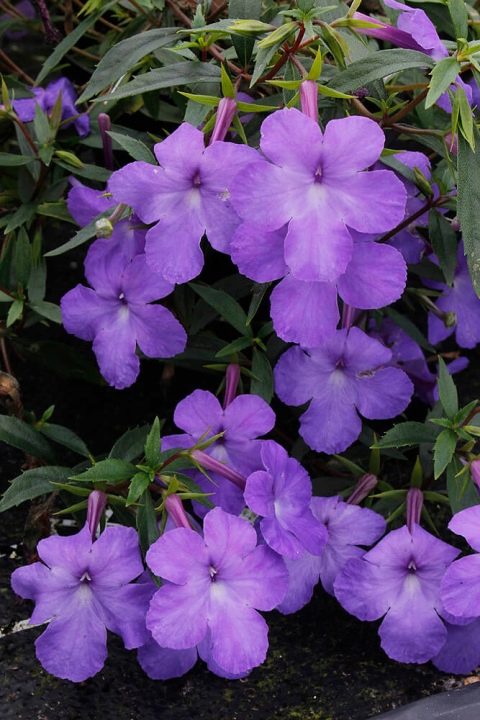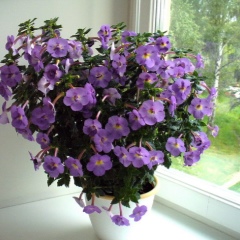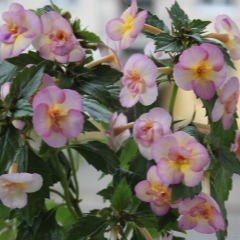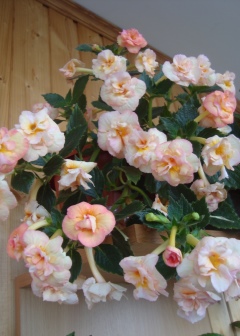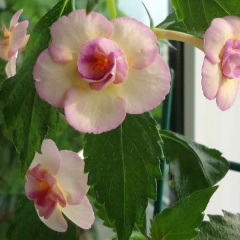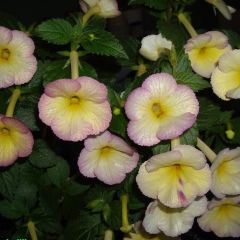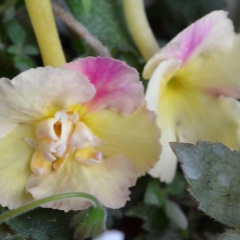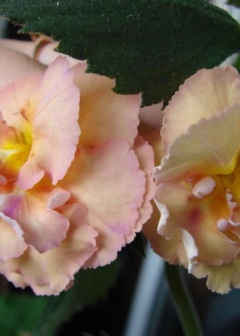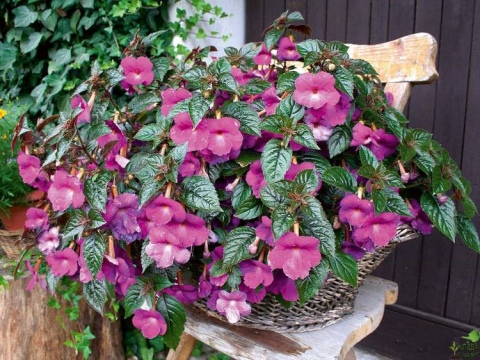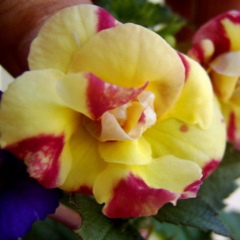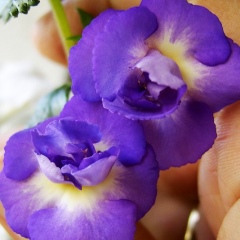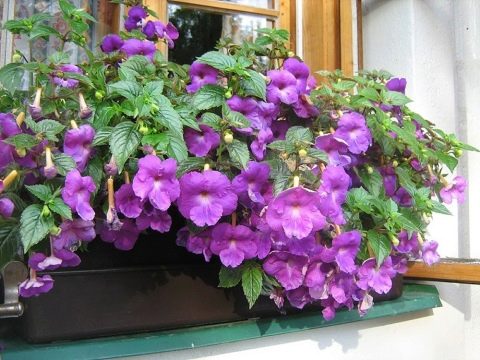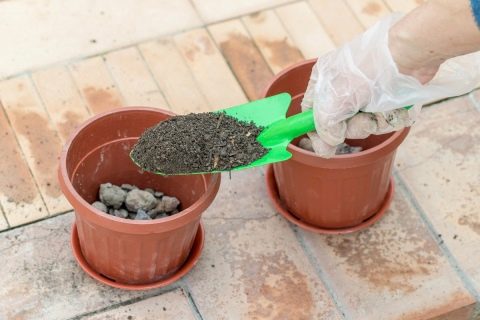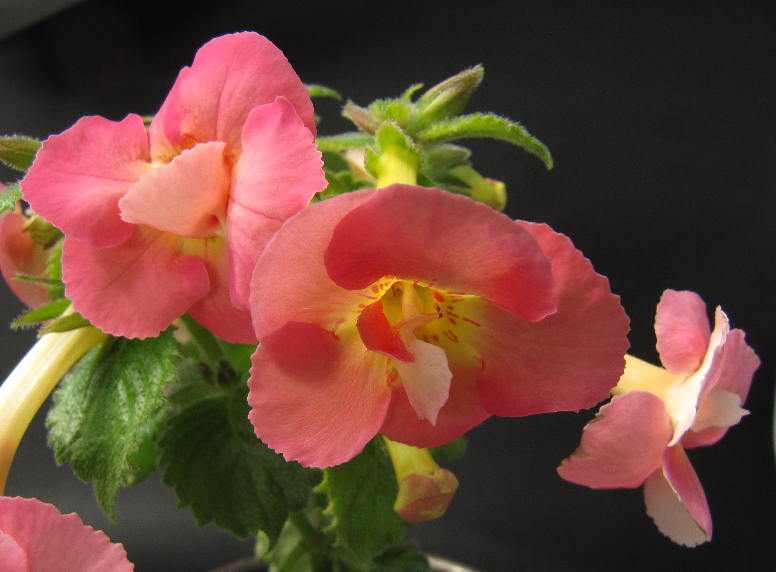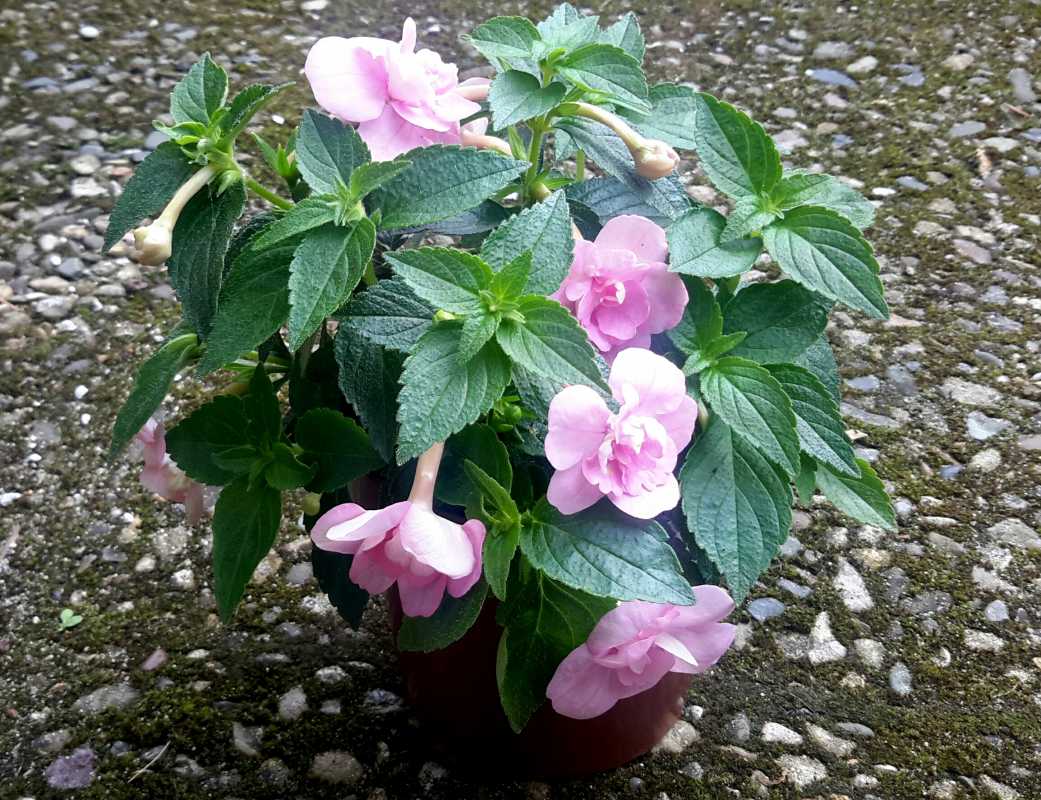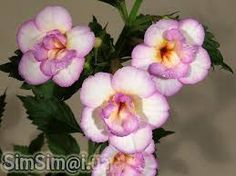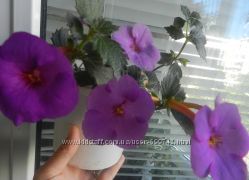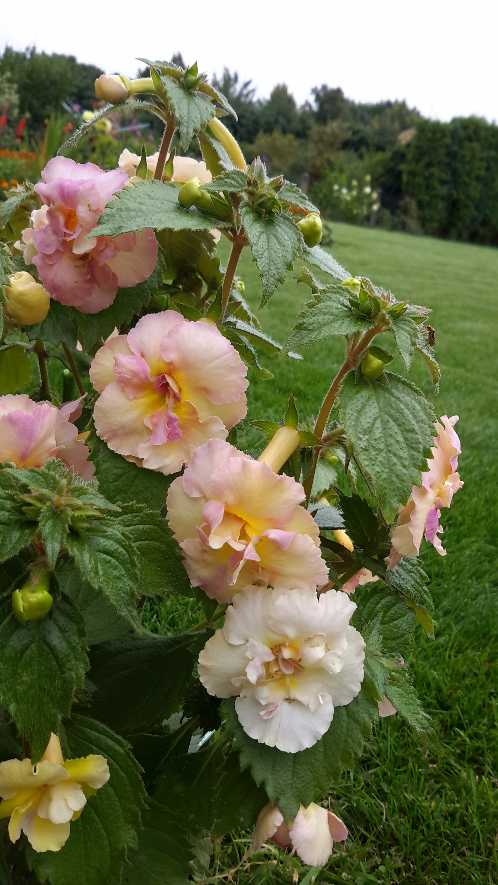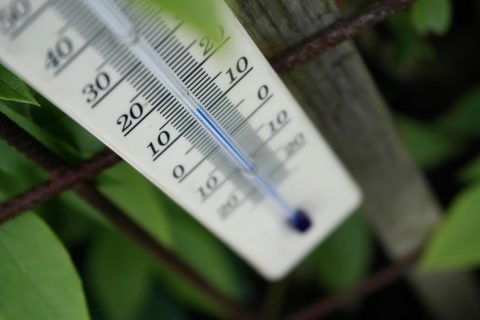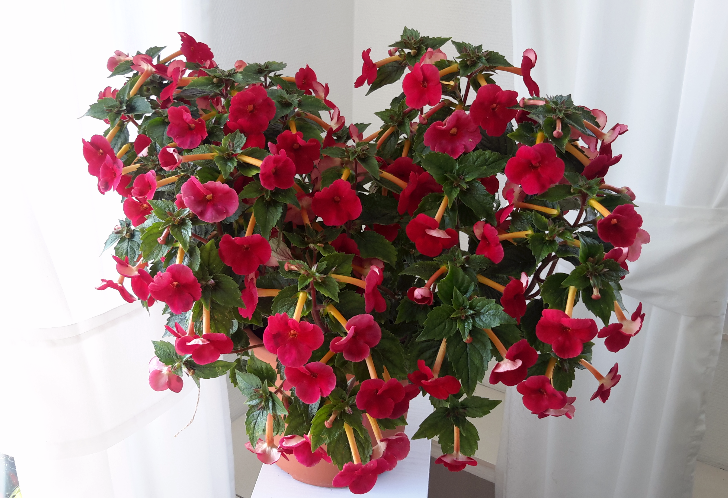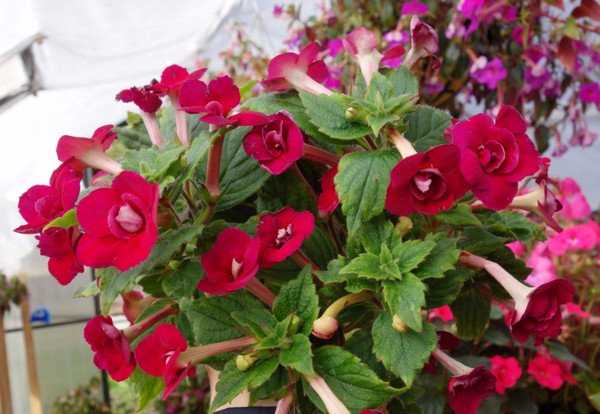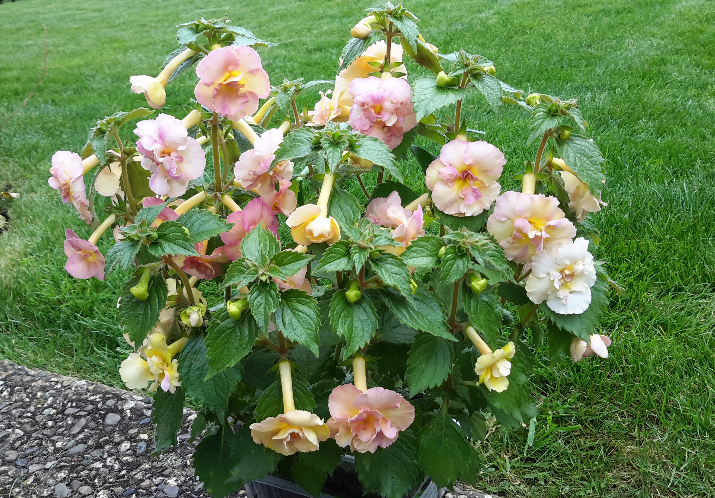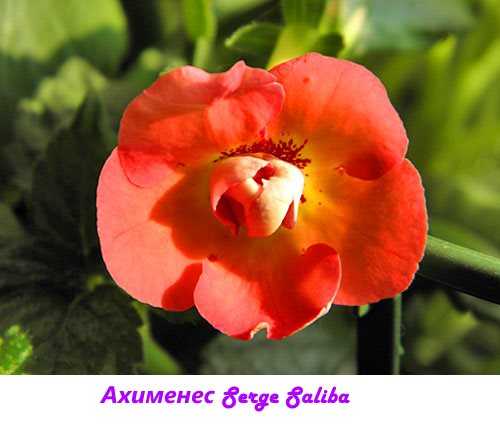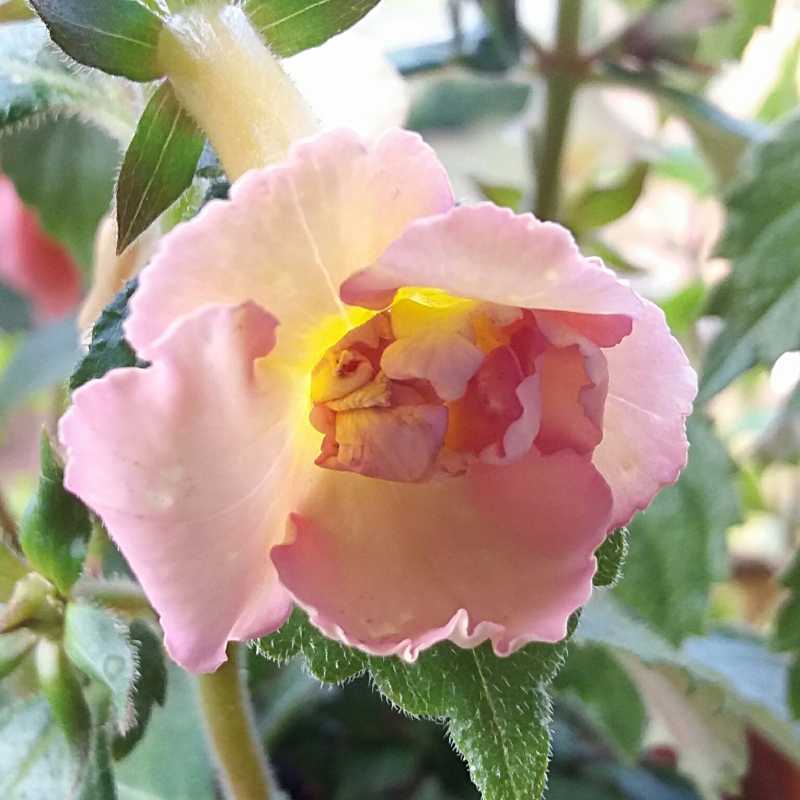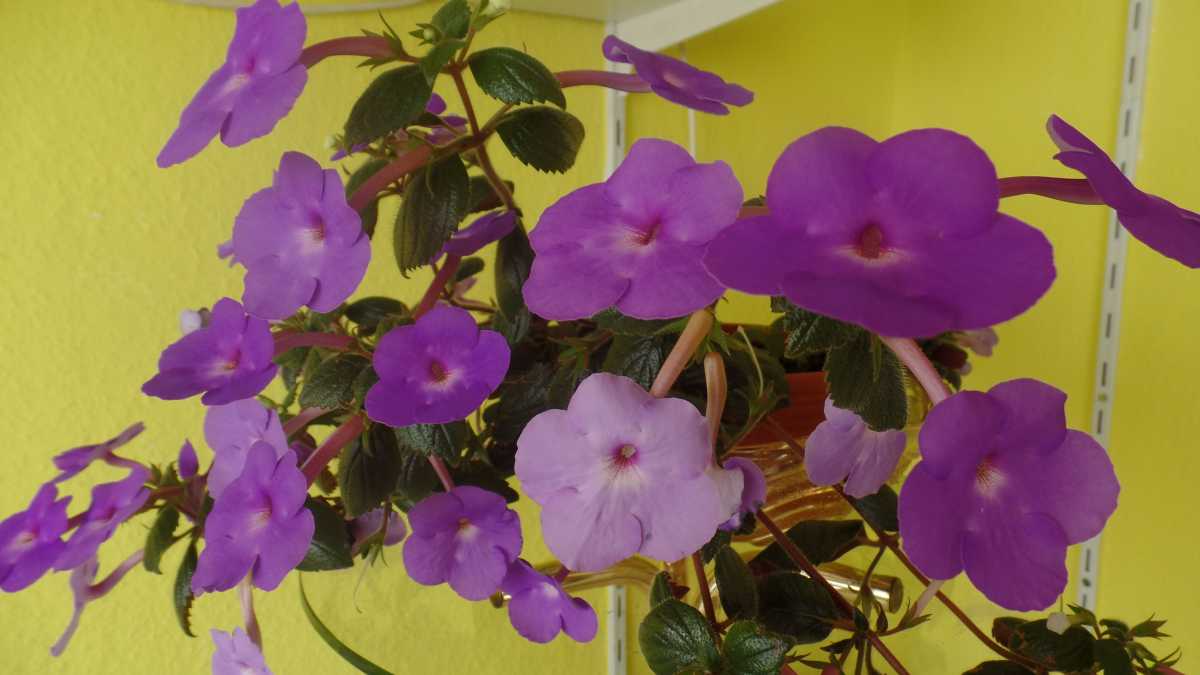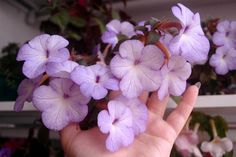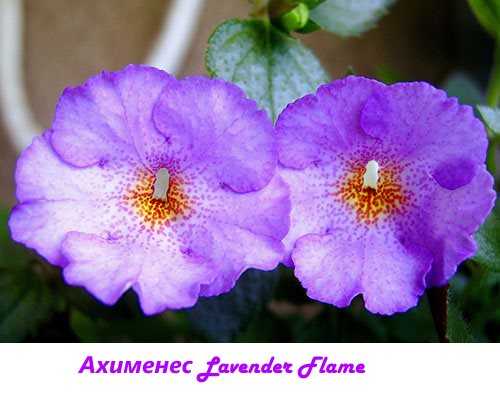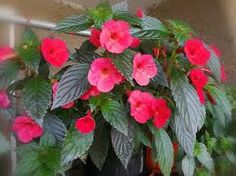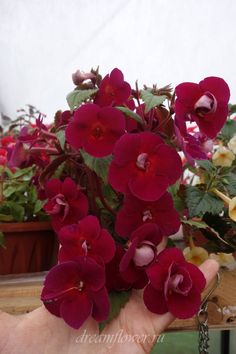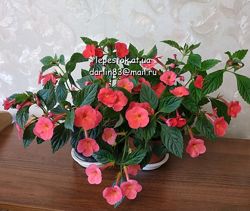Beautiful varieties with photos and descriptions
There are a lot of varieties of achimenes.
Below are photos and brief descriptions of the distinctive features of the popular varieties of achimenes, which will decorate any home and interior.
Ahimenez Little Beauty (Liittl Beauty) - there are many colors, they are bright pink:
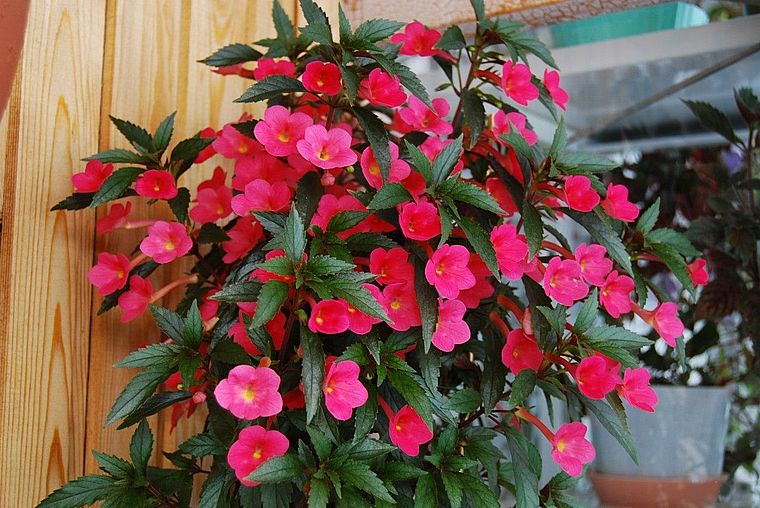
Major (Major) - flowers are very large up to 8 cm in diameter:
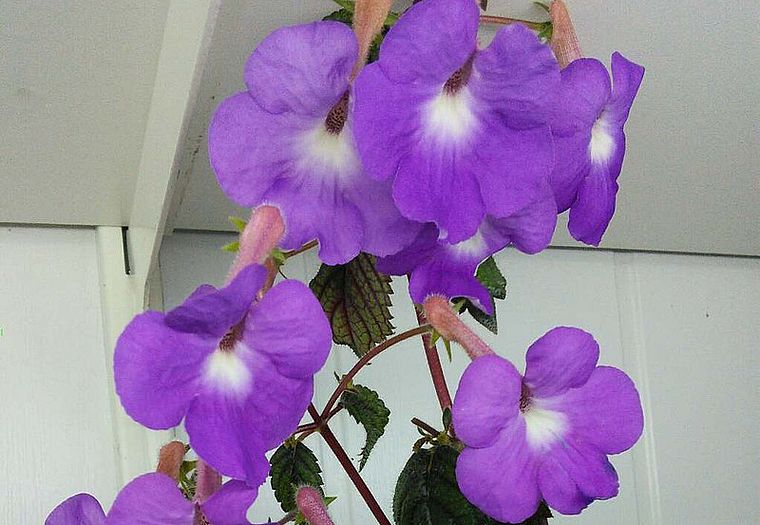
Achimenes Chiapas (Chiapas) - large plants. The shade is light purple. Wavy edges:

Juaregia (Juaregia) - large flowers, diameter up to 6 cm:

Purple King (Purple King) - purple color:
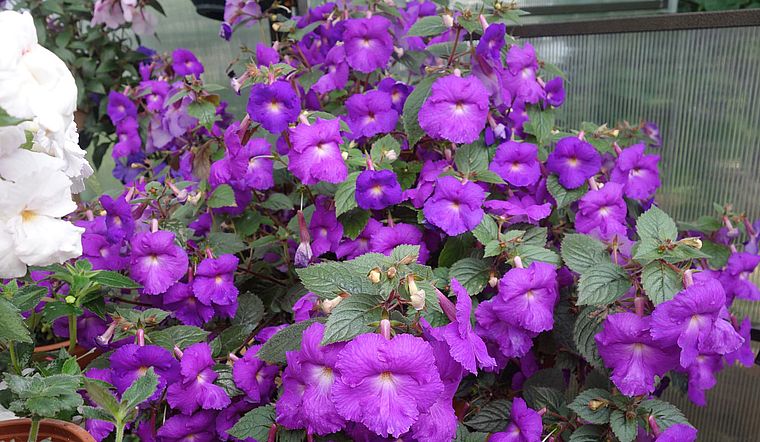
Snow Queen or Snow Princess (Snow Queen or Princesses) - white flowers with a purple tint in the center:
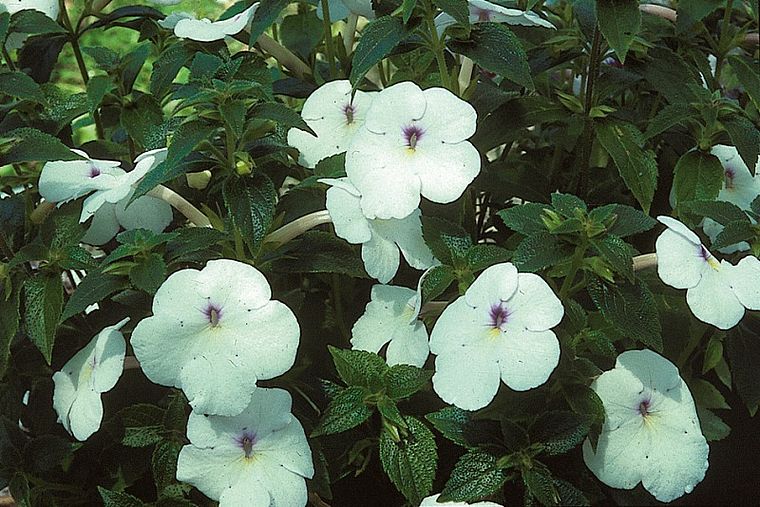
Ambroise Verschaffelt (Ambrois Fershaffelt) - white flowers with thin radical veins:
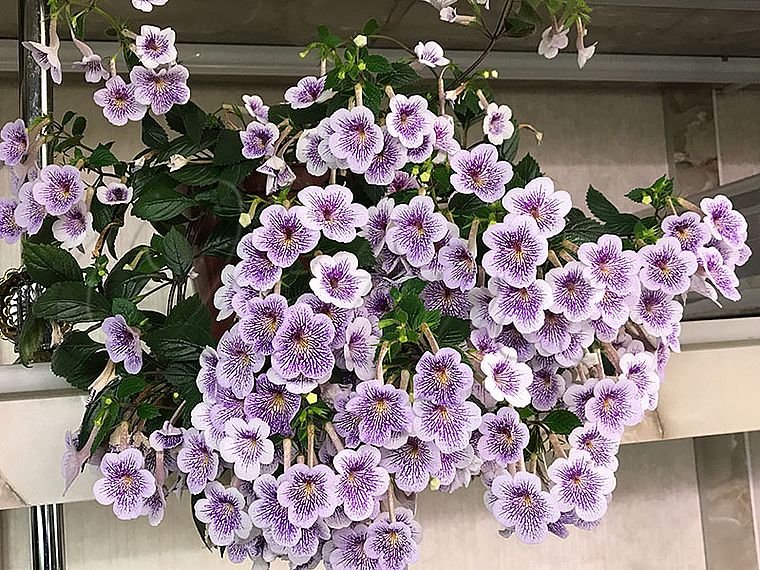
Rose Pink (Rose Pink) - flowers of an unsaturated pink shade:

Blue Star, Planet, Swan, etc. - small-sized flowers of light blue color:
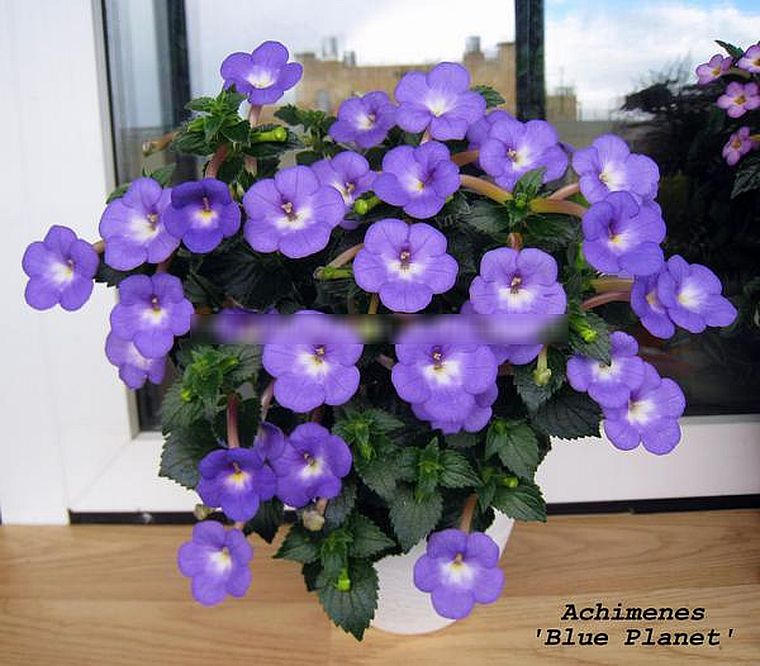
Ahimenes Yellow english rose pink or cream in color, a combination of two shades is possible:

Cote D Ivoire - yellow or white flower with pink edges:
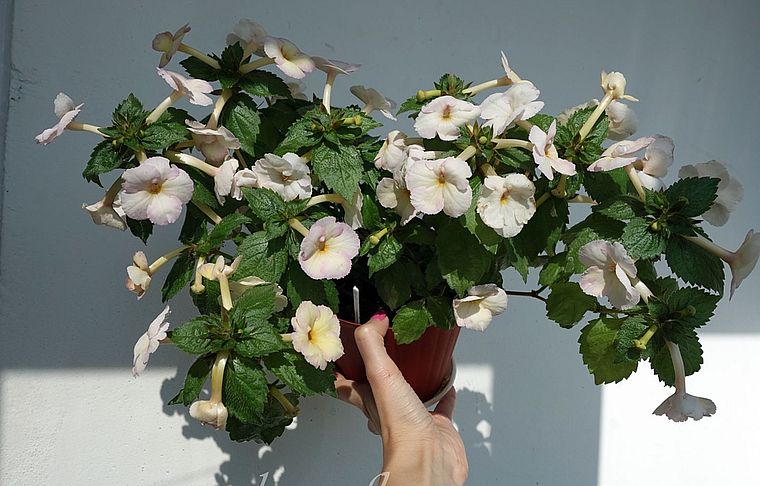
Tropical Dusk (Tropical Dusk) - yellow with a purple tint around the edges and in the center:

Achimenes Giselle (Giselle or Giselle) yellow or cream with a pink or red center:
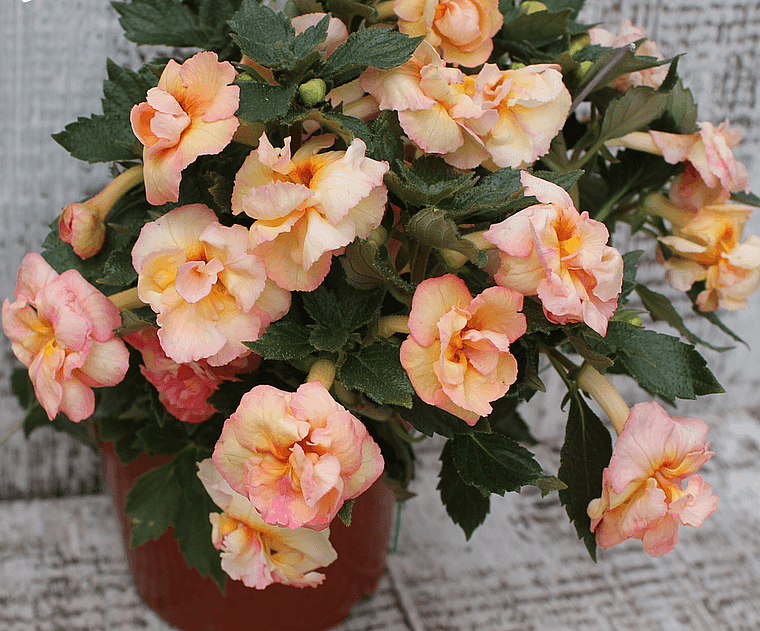
Ahimenes Dot (Dot) - light purple flowers with purple dots in the center:
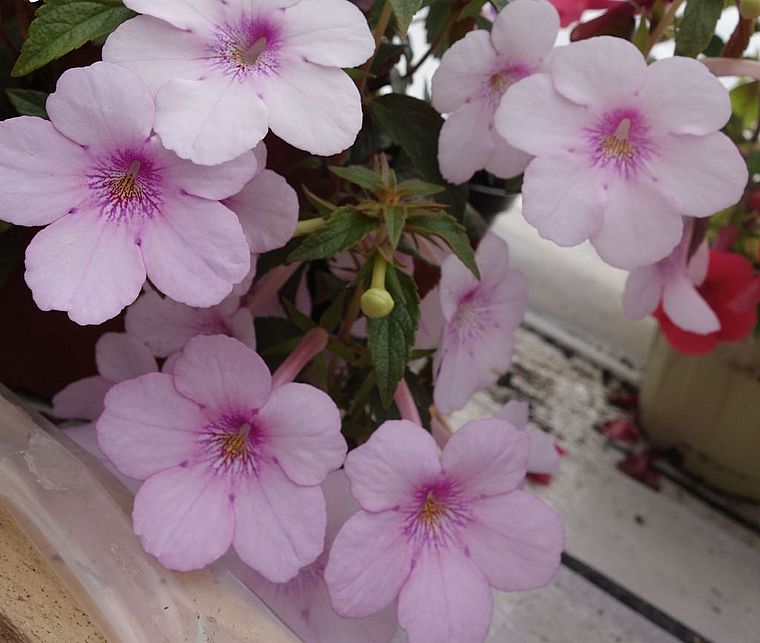
Yellow Fever (Yellow Fever) - pure yellow or with a red tint in the center:

Sun Wind - white with red edges and a yellow center:
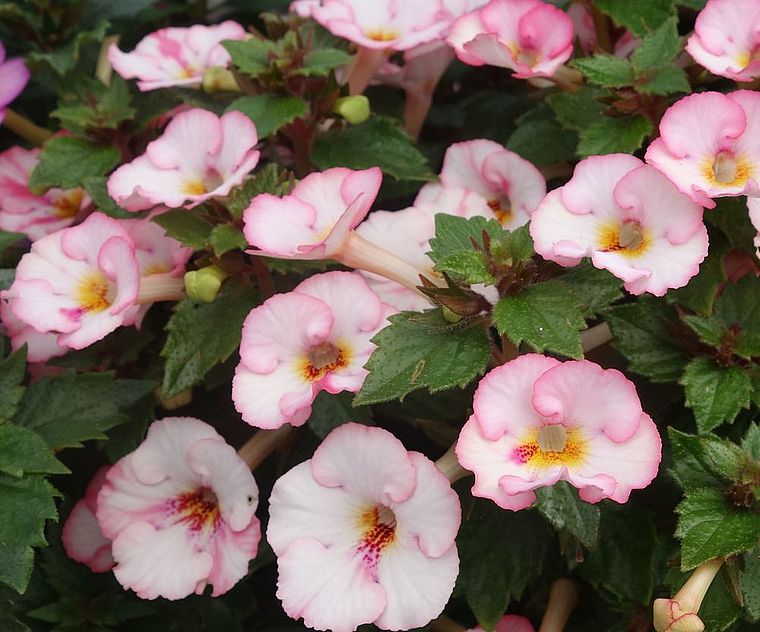
Achimenes Venice (Venice) - purple with a yellow center:
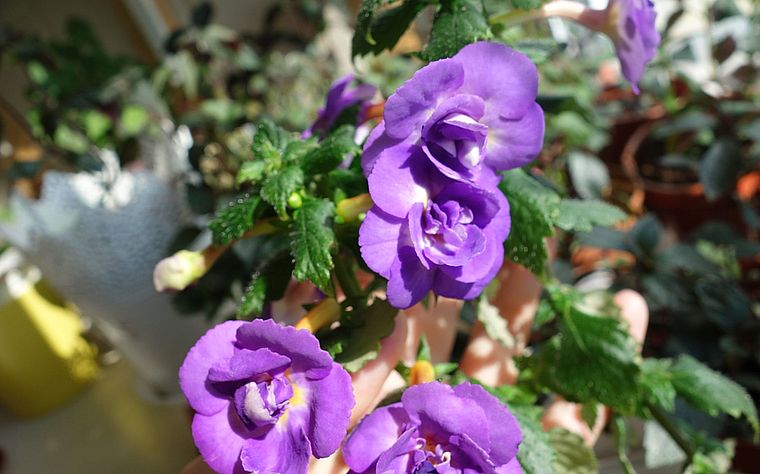
Petite Fadette (Petite Fadet) - red, small flowers:

But photographs of Achimenes varieties only with names, because it is very easy to see the distinctive features with your own eyes.
Ahimenez Sabrine (Sabrina):
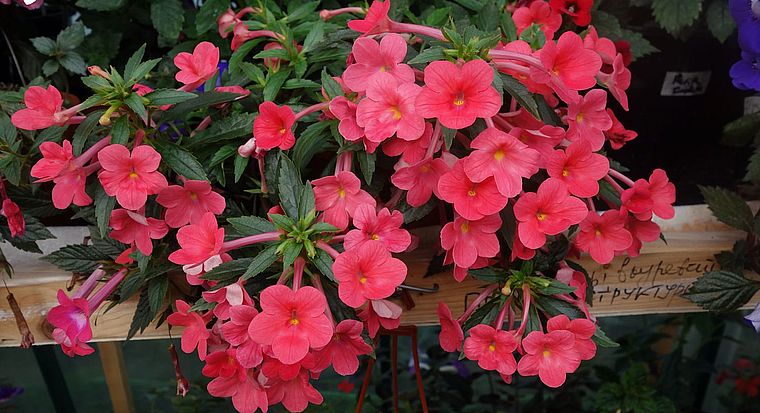
Peach Blossom:
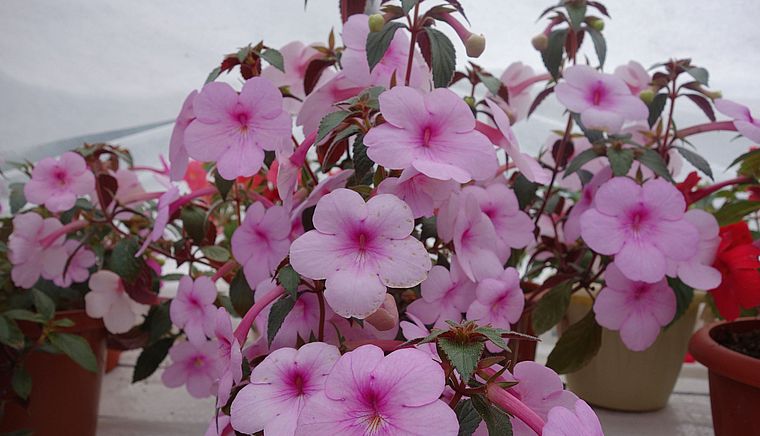
Stan's Delight:

Nocturne (Nocturne):

Ahimenez Serge Saliba:
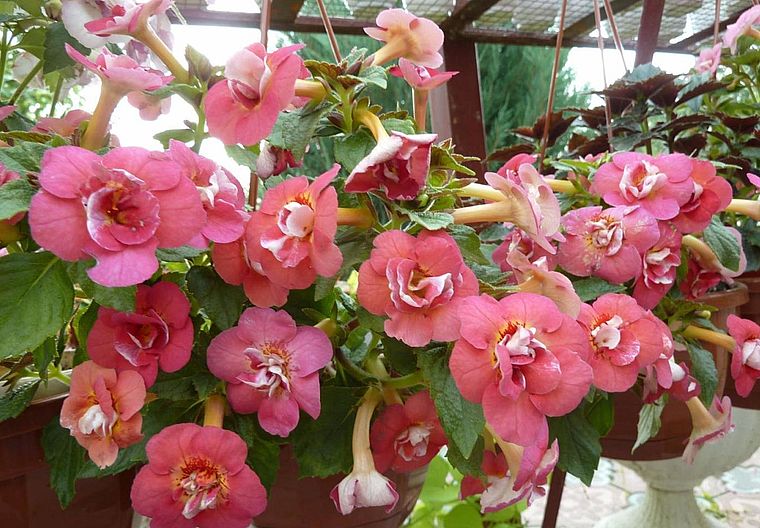
Clouded Yellow:

Peach Orchard:

Hard to Get:
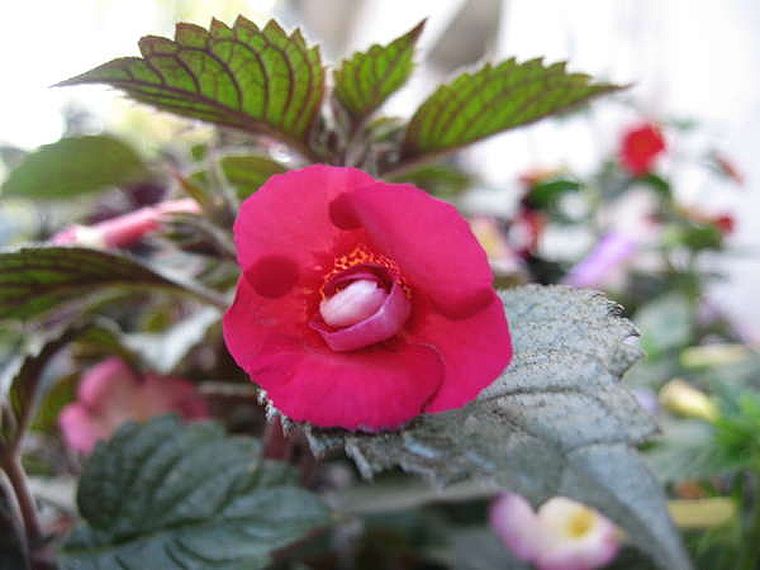
Alter Ego:

Sauline:
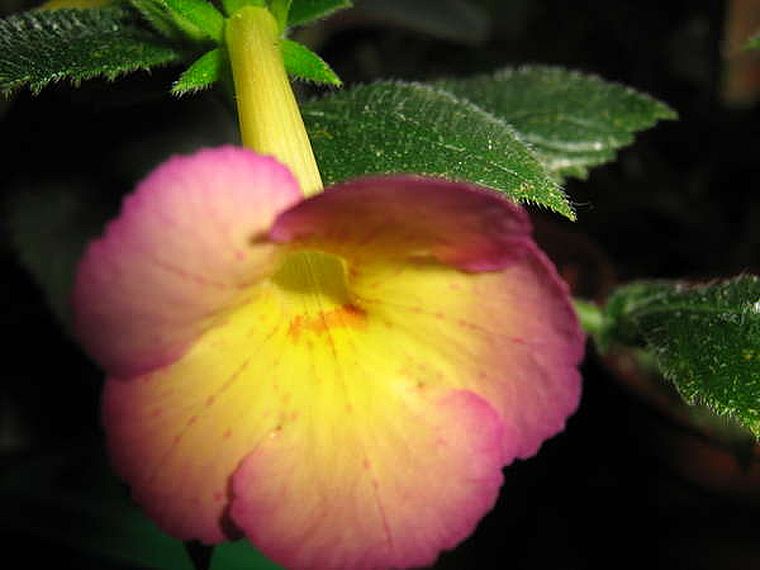
Abyss:
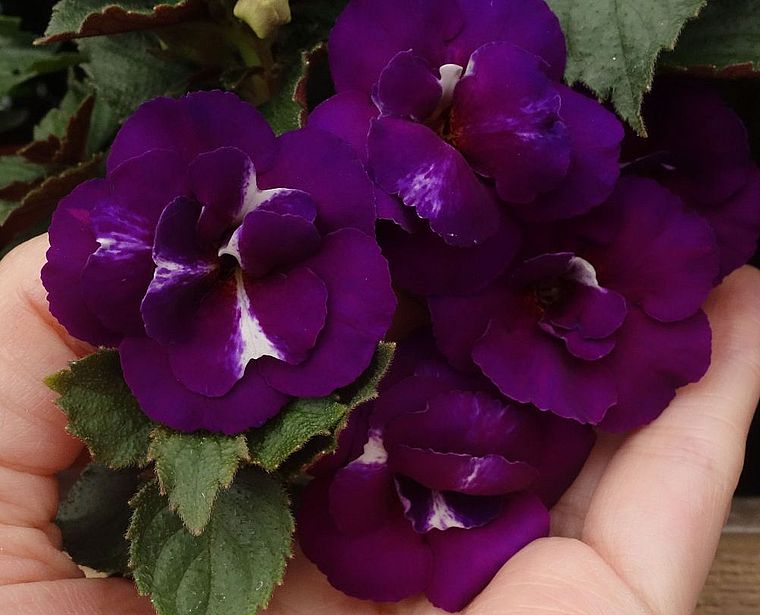
Ahimenez Veronika Gotmanova (Veronika Gotmanova):
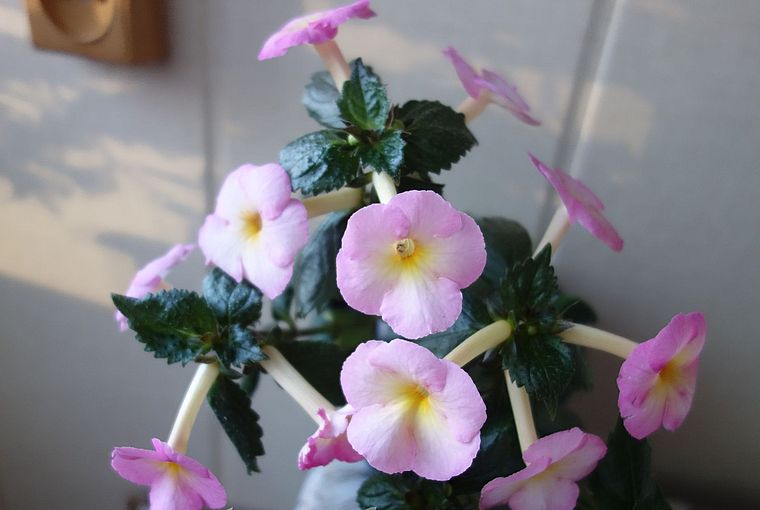
Shy Sun:
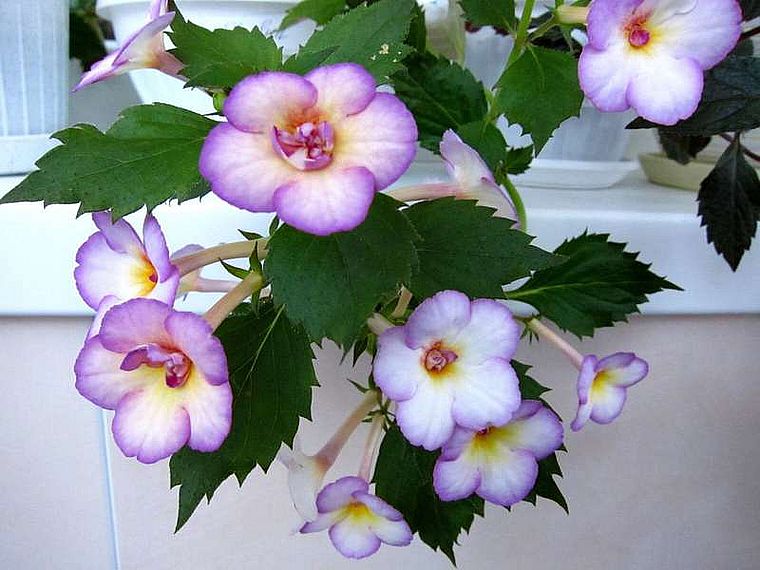
Golden Lady (Golden Lady):

Aurika Ashcroft:
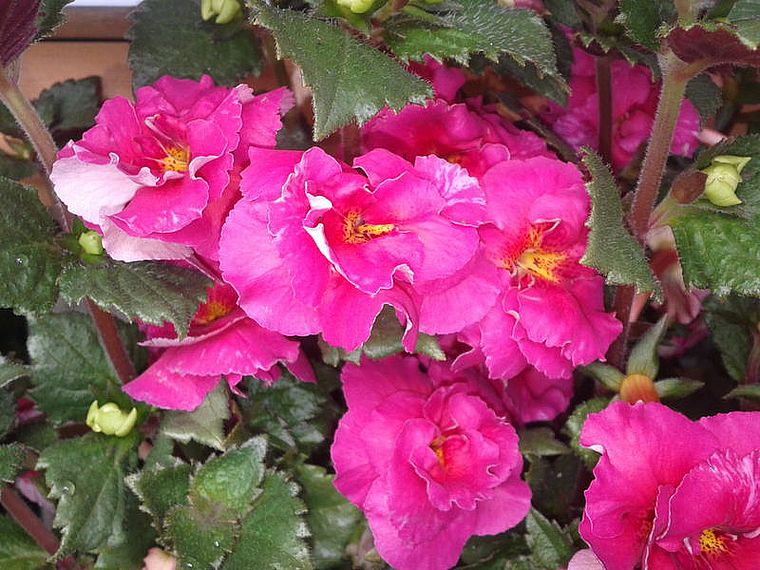
Hot Spot:
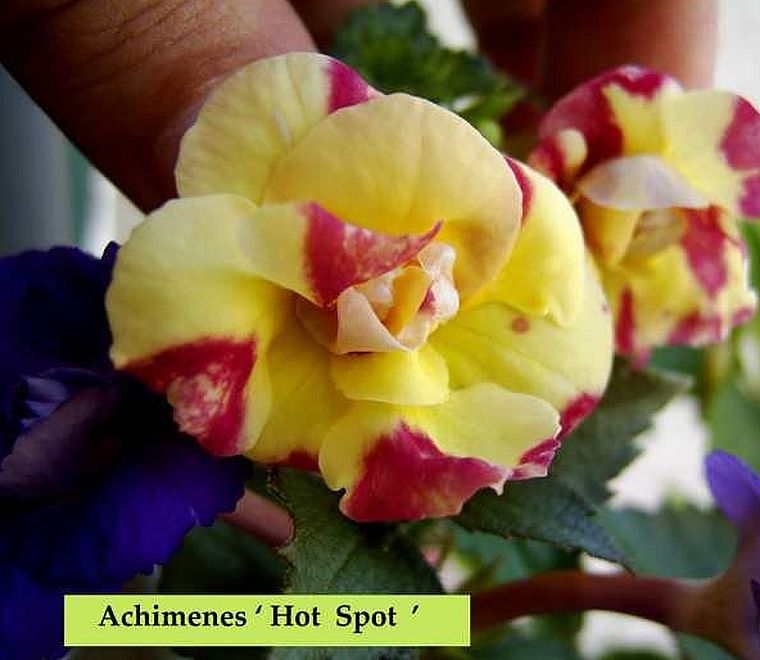
Made in Heaven:

Last Dawn:

Sweet and Sour (Sweet and Zaur):

Rainbow Warrior:
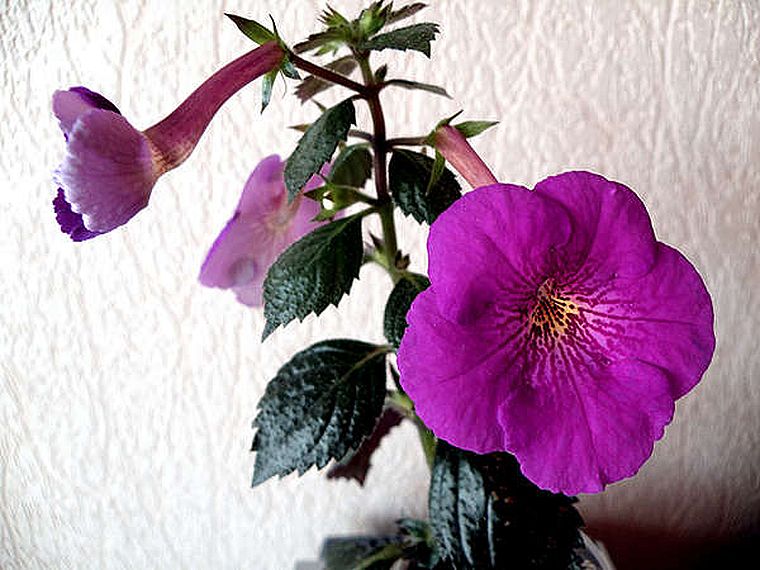
Ice Tea (Ice Tee):
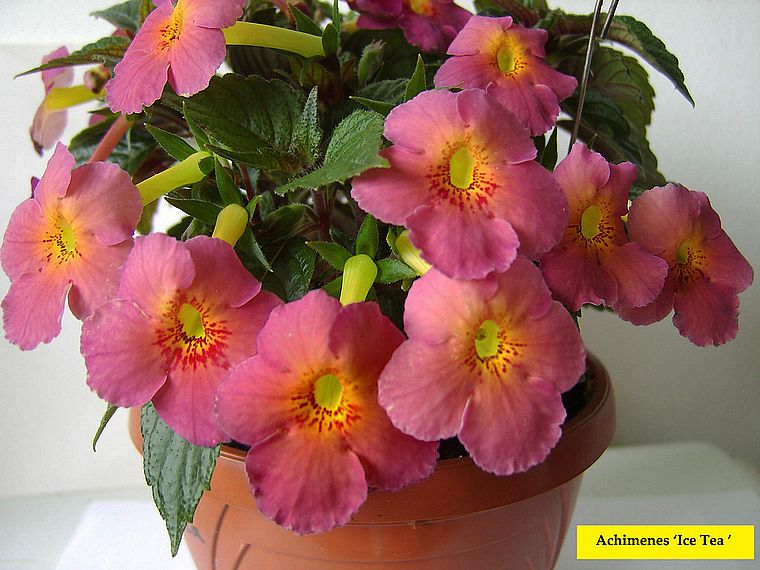
Charles Martel:
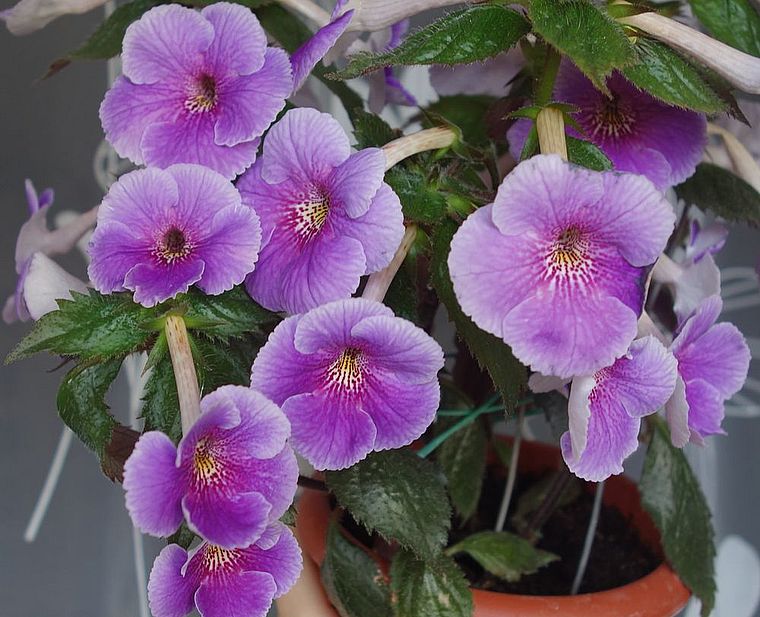
Cytro (Citro):
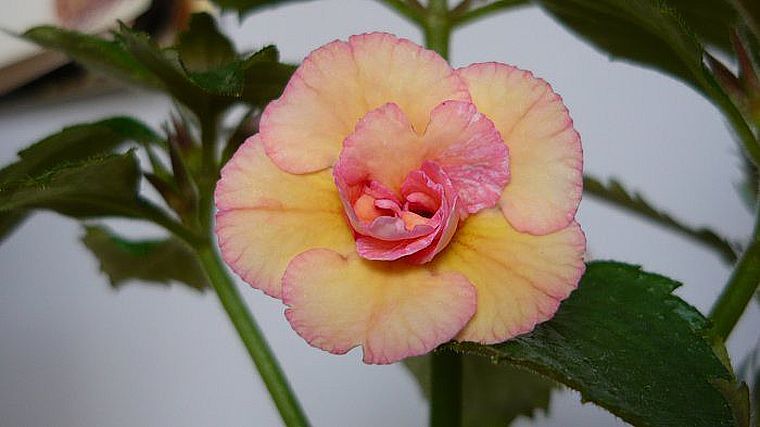
Golden Bells:
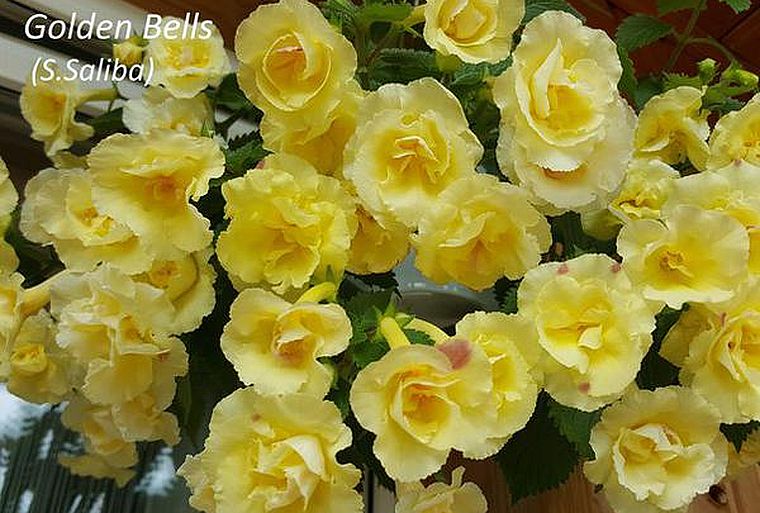
Sun Dance (Sun Dance):

Queen of Lace:
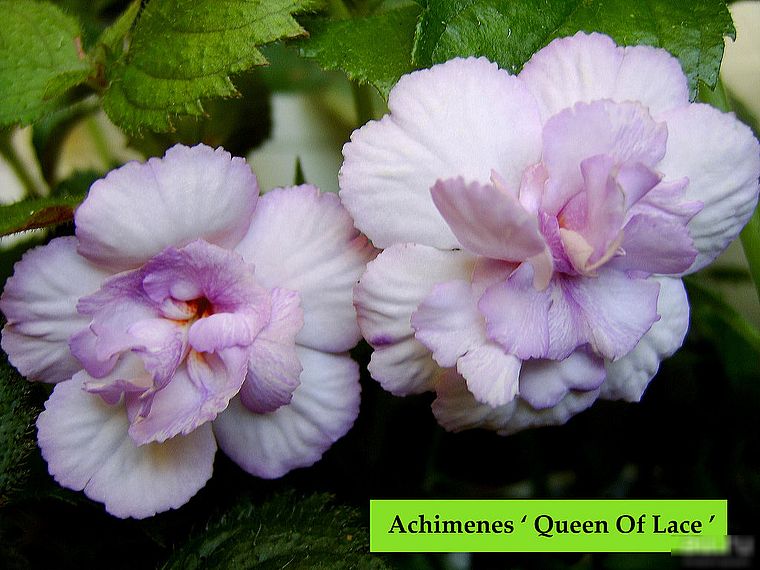
Wild Girl:
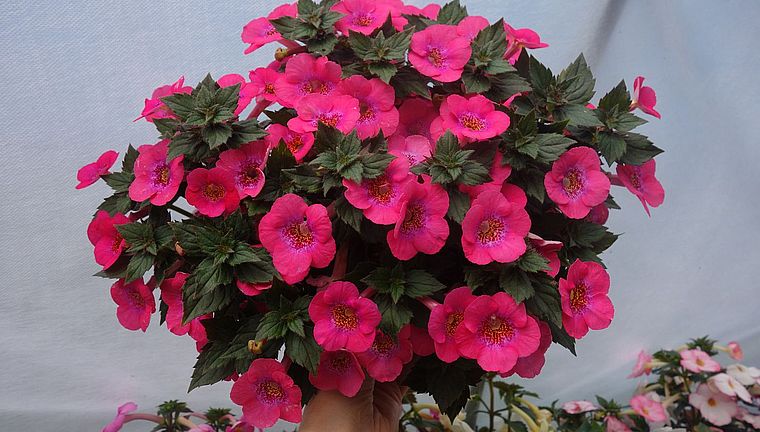
Limoncello (Limoncello):

Strawberry Lemon:
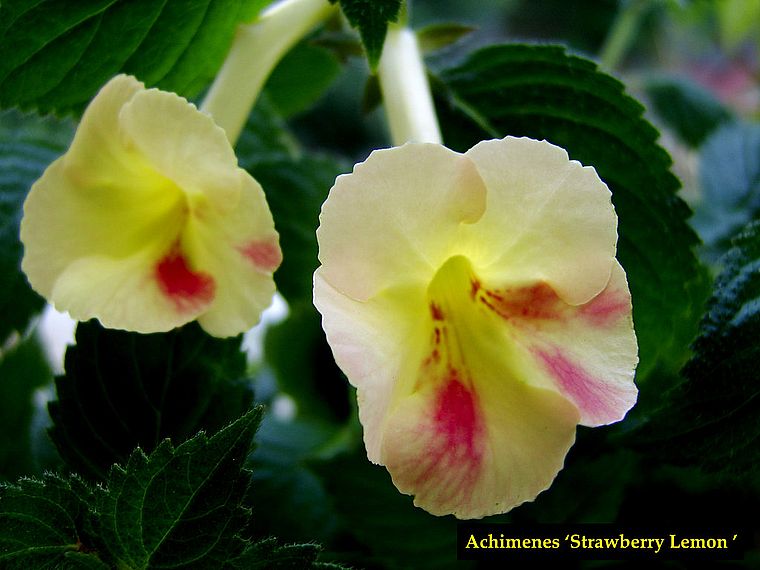
Hugues Aufray:
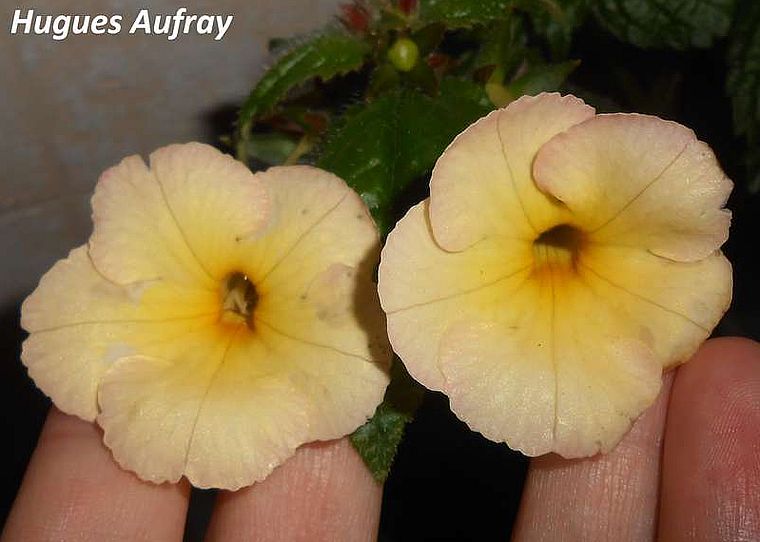
Bianco Natale (Bianco Natale):
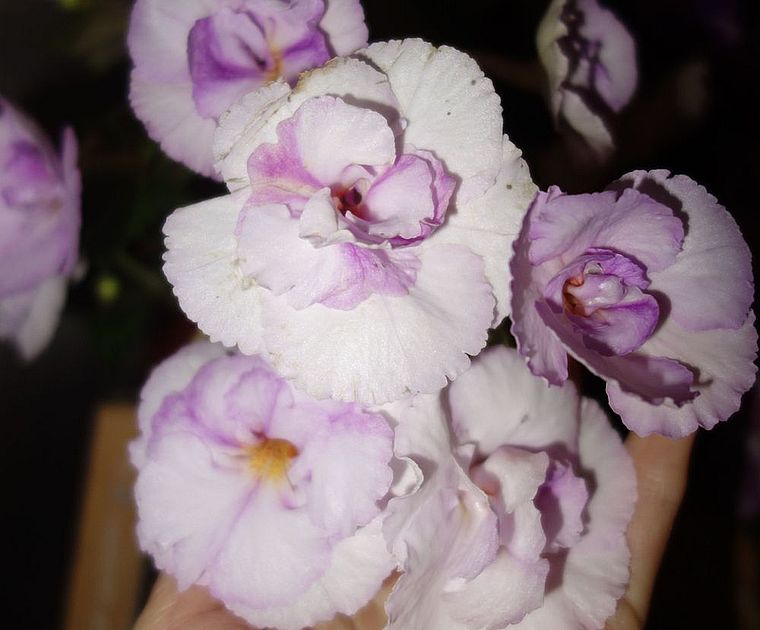
Rosy Frost:
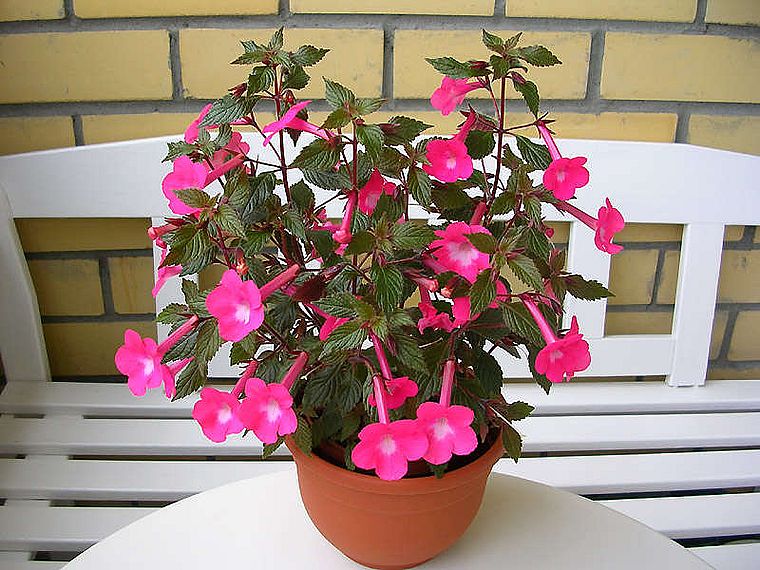
Anastasia (Anastasia):
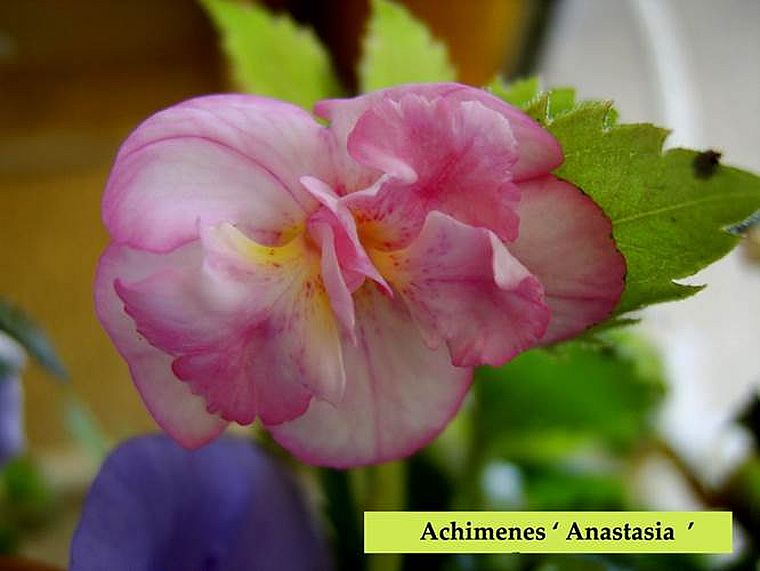
Lena Vera (Lena Vera):

Home care and cultivation
Video about the care and cultivation of achimenes:
Indoor flower achimenes - light-loving plant
But please note that the light intensity depends on the type of plant.
If the leaves are dark, a lot of bright light is needed, and direct sunlight will not harm the flower. If the shape is variegated, a bright diffused room or slight darkening is perfect. But it is better to avoid direct sunlight, as there is a risk of burns on the leaves.
Air temperature and humidity
During active growth, the recommended temperature is from 20 to 25 °. In October, the temperature should be gradually reduced so that the roots gain strength and are ready for a dormant period.
Humidity should be high, but it is forbidden to sprinkle water on leaves, otherwise rot and mold will appear. To increase humidity, you can spray the air around the flower or pour damp pebbles into the pan. The bottom of the pot must not come into contact with water. If water gets on the leaves, there is a high risk of brown spots.
Watering
Abundant watering is required during the growing period. For this, settled water is used. But liquid stagnation should be avoided so that rot does not form. In addition, water should be avoided on the sheet plates. A syringe is used for watering. The water temperature is slightly higher than room temperature.
Fertilizers and feeding
Top dressing begins one month after the emergence of young shoots. Fertilizer should be mineral-based. It is brought in once every 2 weeks. As soon as the flowering period ends, you can stop feeding.
Dormant period
In caring for achimenes at home, it is very important to properly treat his dormant period. In autumn, the leaves of the plant begin to dry.
After trimming, the pot is removed to a cool and dark place, the temperature is 15 °. Watering should be reduced from the end of September. After pruning, the soil should be moistened once a month with a little water. If you use a lot of water, the plant can start to grow.
In the fall, the leaves of the plant begin to dry out. After trimming, the pot is removed to a cool and dark place, the temperature is 15 °. Watering should be reduced from the end of September. After pruning, the soil should be moistened once a month with a little water. If you use a lot of water, the plant can start growing.
If the flower woke up ahead of time, transfer it to a bright place.
At the end of March, a period of active growth begins. Ahimenes needs to be watered and fed regularly until next fall. We put the pot in a warm room with a temperature of about 22 °
A lot of light is important. After this, active growth and the appearance of buds begins.
Pruning
After part of the bush has dried above the ground, you can prune it. If it is carried out earlier, the roots will not have time to get the nutrients needed during the dormant period from the plant.
Transfer
Usually the rhizomes of the plant grow at a temperature of 18 ° C. An important role is played by abundant watering and light. If you store the rhizomes in the sand in winter, active growth begins after transplanting into a pot.
A transplant is needed if the houseplant has grown too large and a larger pot is required. It is also performed if the achimenes is attacked by insects or diseases. Can be transplanted into other soil if more nutrients are required.
The transplant is performed at the beginning of February. The roots are short enough, so a low pot will do. If the root is too large, it can be divided into pieces and planted in several pots. You need to cut the roots so that there are growth points on all the divisions. After the cut site has dried, it is sprinkled with coal in the form of a powder and planted in a substrate. A drainage layer is made at the bottom, filling half of the pot. For this, pieces of brick or expanded clay are suitable. The drainage layer is covered with soil. The composition can be as follows:
- leafy soil with sand;
- sand and peat;
- humus, sand and leafy soil.
Any mixture requires the use of a small amount of fine coal. We place the root in the pot, pressing it a little into the soil. We fall asleep with the mixture.
Video about pinching achimenes and caring for them at home:
Achimenes breeding methods
At home, achimenes reproduces by dividing underground and aerial rhizomes, apical or leafy cuttings and seeds.
Reproduction by rhizomes
The first method is the simplest, since the rhizomes take root very quickly. Reproduction is carried out during plant transplantation.
We select healthy, dense roots, divide them into two or three parts, sprinkle the cuts with ground cinnamon and place several pieces in a pot in a substrate moistened with warm water.
Then cover with a layer of soil and cover with foil to create greenhouse conditions.
We put the pot in partial shade. We periodically moisten the earth.
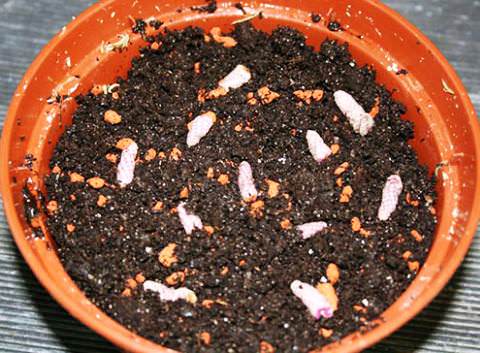
After 2-3 weeks, the first shoots can be seen. We remove the cover, and put the pot with young plants in a well-lit place.
In some ampelous varieties, air roots-rhizomes are formed on the shoots. They can be separated with part of the stem and placed in the ground for rooting.
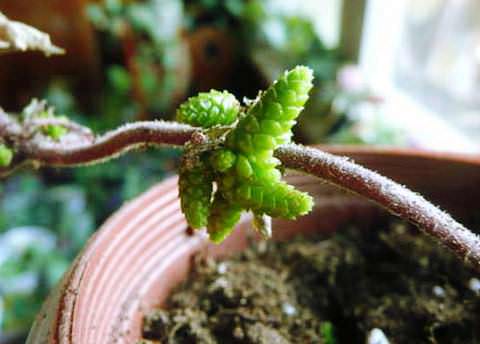
Propagation by cuttings
A more laborious method of propagation by cuttings. For rooting in the summer, take top cuttings 6-7 cm long or large healthy leaves. In cuttings, the lower leaves are cut off.
Cuttings and leaves are placed in water or placed in a wet mixture of sand and flower soil and covered with a plastic bottle or bag. Maintain moderate soil moisture. The roots form in about two weeks.
The method has a significant drawback - by the time it is necessary to retire, the rhizomes have not yet had time to accumulate nutrients and the plant will be very weak. And without a dormant period, there will be no flowering.
In this case, flower growers recommend maintaining the growth of young bushes for as long as possible with phyto lamps and watering, and only allow them to fall asleep at the end of November.
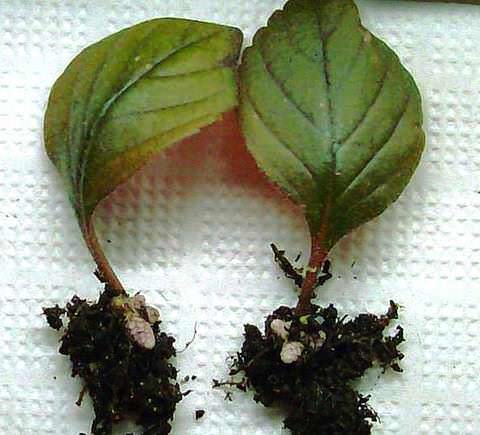
Rooted leaf cuttings
Seed propagation
The seed method does not convey the varietal characteristics of the parent plant, so it is better to sow purchased seeds. Sowing is carried out at the end of winter in a wet mixture of earth and sand. We put the container in partial shade and periodically spray the soil.
For quick germination, it is better to cover the container with a film, which we periodically remove for airing. When the first 2-3 leaves appear on the seedlings, they are dived and transplanted into separate pots for 3-4 shoots. At the stage of 6-7 leaves, pinch the top to stimulate branching.
How to grow achimenes: care and optimal home conditions
To grow achimenes at home, you need to know the basic rules of care. For a tropical perennial, you need to create optimal conditions, otherwise it will be sick and will not bloom in full force. Some growers are disappointed in the plant due to the fact that it does not give such flowering as in the photo. Therefore, Achimenes is abandoned without even trying to create comfortable conditions.
Air temperature
The optimum temperature during the active period of life is +22 degrees. Ahimenez sustains an increase of up to +30. In no case do not allow drafts to affect the plant. If Ahimenes blew cold air during the flowering period, then he will lose some of the flowers. In autumn, after the buds wither, we lower the temperature to 12-15 degrees Celsius.
Lighting and hours of sunshine
This is a light-loving plant. For him, I recommend at least 6-8 hours of sunshine a day. Lighting should be bright, diffused. In no case do not place the perennial on the balcony or garden, otherwise the buds will not be bright and the shoots will begin to stretch.
Humidity and watering
Ahimenes loves humid air. Therefore, it is placed in a pot next to aquariums and other direct sources of moisture. During the rest period, watering is reduced to 2 times every 30 days. In summer, the plant needs a lot of moisture. But, it cannot be watered from above. It is better to do this through a pallet. The water temperature is slightly above room temperature.
Fertilizers and nutrient formulations
We use fertilizers for indoor flowering plants with a low nitrogen content. I don't recommend organic (although you can try fish emulsion as an experiment). The frequency of dressings is 1-2 times every 30 days, by the root method.
Achimenas transplant
This is a delicate process. Try not to damage weak root rhizomes. At this time, you can practice root propagation. Achimenes is transplanted annually, in the spring. Method - transfer to a wider pot. To make it easier to get the root system out of the container without damage, water the perennial.
The optimal composition of the soil for achimenes: charcoal, humus (peat is possible) mixed with sheet soil.
Achimenes varieties by color
For example, for those who want to grow bushes with yellow flowers, you can pay attention to the following varieties:
- Ahimenes Sun Dance. A feature of this species is the presence of the original brownish-red speck located in the central part of the bud;
- jimenes "Giselle" Giselle.
The varieties, the buds of which are painted in lavender and purple colors, include:
- Ahimenes Avender Fancy;
- Tropical Dusk;
- Daisy Boo ("Daisy Boo");
- Peach Blossom;
- Snoweetta;
- Hugues Aufray;
- achimenes lavender fancy;
- Achimenes Venice ("Venice");
- Achimenes Poseidon "Poseidon";
- Vivid ("Vivid");
- peach blossom;
- purple kimono.
Varieties with pink inflorescences include:
- achimenes Sabrina;
- achimenes Painted Lady;
- Ahimenes Peach Glow;
- Veronika Gotmanova "Veronica".
The varieties whose buds are colored red include:
- achimenes red Stan`s a Delight ("Stance Delight");
- Lady in Black
Be sure to read Ahimenes: care and cultivation
Peculiarities
Akhimenes belongs to the genus of flowering plants from the Gesneriev family. It is a perennial rhizome herb, which blooms with beautiful multi-colored inflorescences... This flower is considered a relative of Gloxinia and Violet. It is characterized by the brightness and abundance of flowering.
The root system is a rhizome in the form of rhizomes, covered with scales and very reminiscent of birch catkins or spruce cones. The flower has weak stems and weakly branching shoots, covered with a shell of dark green color, sometimes with a reddish tint. The stems can grow vertically or fall down and spread.
The outer surface of the leaves is smooth and shiny, veins stand out well on it. Their color can be deep green, pinkish and even crimson. The inner side is slightly pubescent. The leaves are oblong, the edges are wavy, finely toothed.
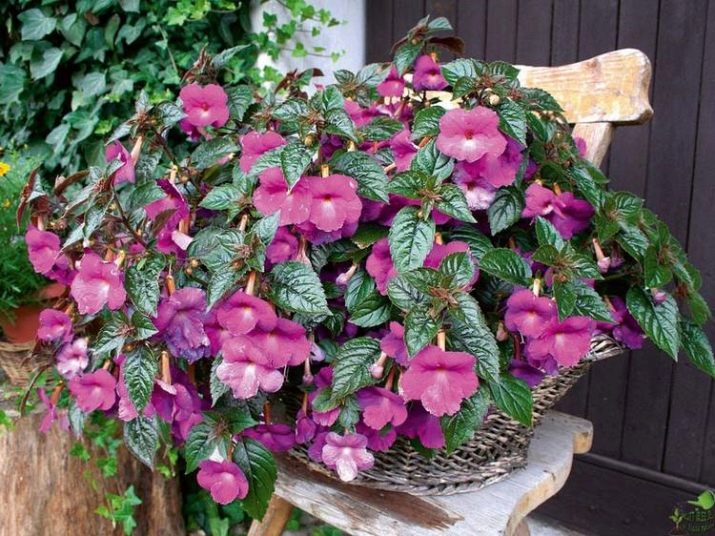
The genus of this flower is distinguished by many species (about 26), varieties and bred hybrids. The main types of Achimenes are subdivided according to such characteristic features.
- Growth type of stem and shoots. Ahimenes are divided into straight, semi-ampel and ampel growing. In upright achimenes, the stem grows vertically, and the lateral shoots grow to the sides, forming a bush. Ampel plant species have a flexible stem, which is lowered down, and creeping shoots. In semi-ampelous Achimenes, curly shoots require a direction of growth.
- Plant size. The height of the flower can fluctuate between 25-50 cm.
- Type of inflorescences. Flowers are simple with smooth petals, semi-double or fully double.
- The size of the inflorescences. Achimenes flowers can be small (2.5-3 cm), medium (3-4.5 cm) and large - up to 6 cm in diameter.
- Color coloration of inflorescences. The color scheme is represented by almost the entire palette of shades: white, various shades of red - from pink to burgundy, purple and blue, yellow and orange. By color, two species are especially distinguished - candida (white) and coccinea (bright red or purple-red shades).
- The shape of the buds. They are round, elongated, or bell-shaped.
Ehrenberg's view is atypical for the Achimenes genus. Lettuce leaves are egg-shaped with a very thick pile (like cotton wool) on the inner surface. Bell-shaped inflorescences are painted in lavender tones.
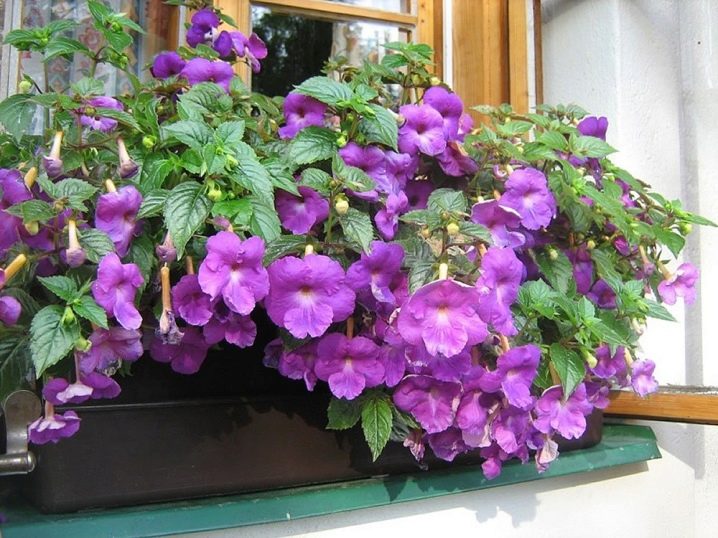
Popular species with photos and descriptions
The number of species exceeds several hundred. Differences in color, shape or size. But there are the most popular types.
Ahimenes grandiflorum
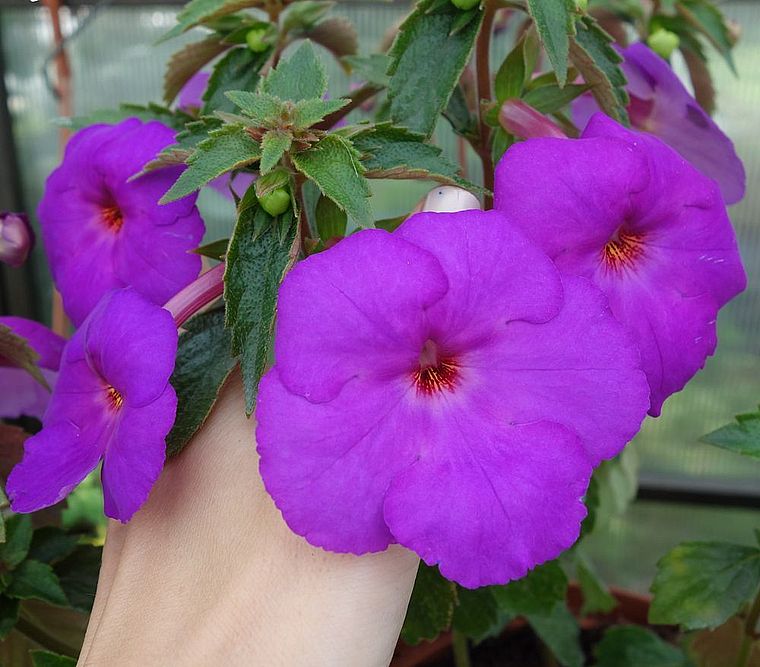
Achimenes grandiflora (Achimenes grandiflora) grows in Mexico. Height can exceed 50 cm. Large leaf plates, width - 6 centimeters, length - 10 cm. Flowers grow from leaf axils, shade red-purple. 2 flowers grow from one sinus. Blooms from early summer to autumn.
Long-flowered
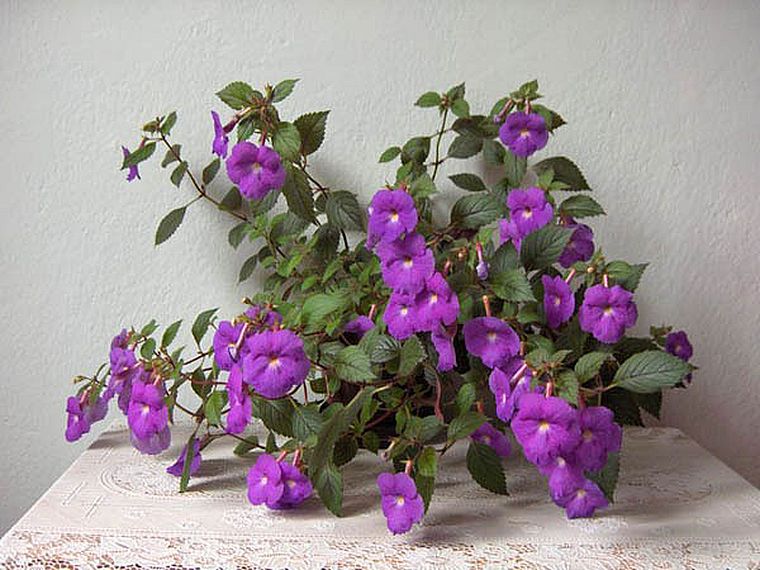
Achimenes longiflora (Achimenes longiflora) is a scaly rhizome. The plant is perennial, herbaceous, growth is about 30 centimeters. Shoots are green, there is pubescence on the surface. Leaves are oblong with pubescence and serrated edge. The flowers are purple, large, solitary, growing from the axils of the leaves. There are many varieties and forms. Blooms from April to October.
Mexican
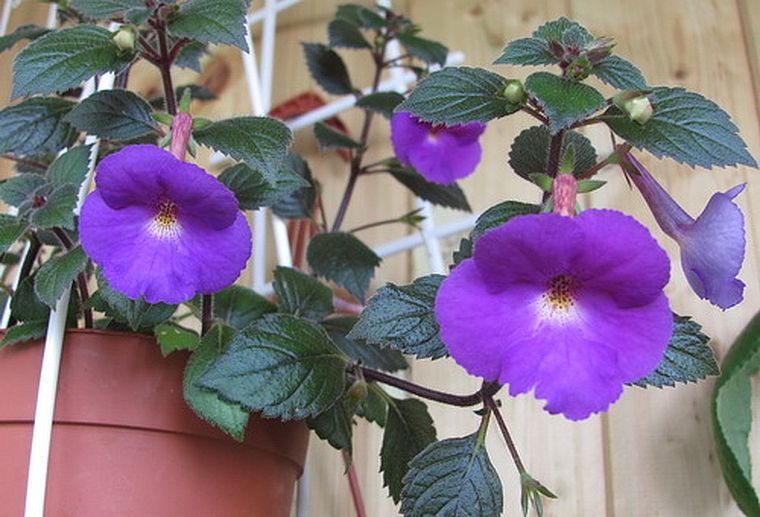
Achimenes Mexican (Achimenes mexicana) has ampelous pubescent shoots up to 40 cm in length. The leaves are dark green above, reddish below. The flowers are wide, reddish-purple with a white throat. Blooms from June to October.
Lion's

Achimenes lvynosevovy or Entyraina (Achimenes mexicana) with medium-sized flowers. Leaves are soft, pubescent. Flowering is not abundant, but the flower itself is very beautiful: painted, with different strokes and stripes.
Tiny
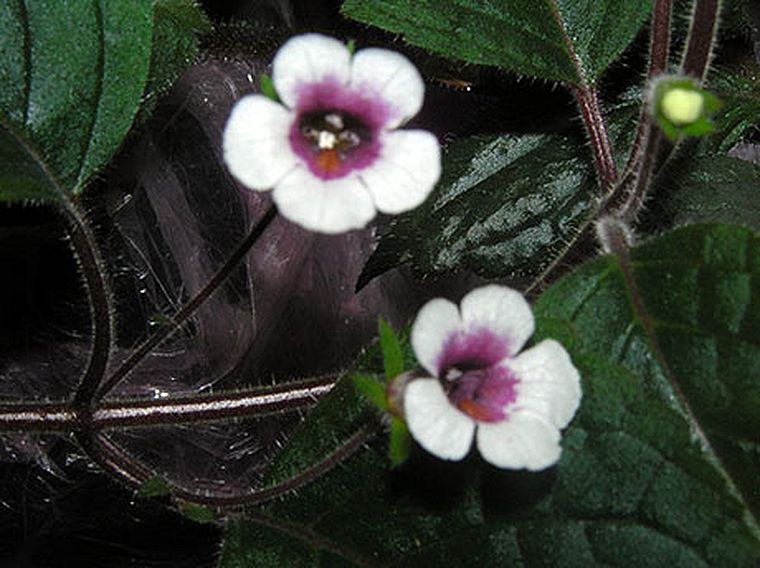
Achimenes tiny or miser (Achimenes Misera). Distinctive features - small flowers up to 1 cm in diameter with a purple spot in the center. The leaves are dark green.
Ahimenes - home care and cultivation
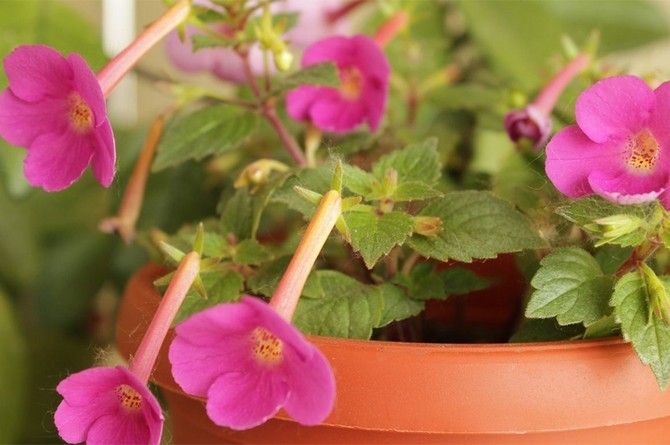
Good plant care is a guarantee of beauty and long-term flowering. Observing the simple rules for keeping such a plant, you can admire the abundance of its colors for 4 months.
Location and lighting
A young plant that has not yet bloomed can be placed on a window on the south side, slightly shading from the direct rays of the sun. To a greater extent, Achimenes prefers well-lit places, but it all depends on the stage of development. With the onset of flowering, it is still better to rearrange the plant to a less sunny side. The lack of light can be understood by the state of the flower: its stems will stretch out and they will be bare.
Important! A plant with dark leaves is more fond of light than light
Temperature
For the successful maintenance of a flower, compliance with the temperature regime is very important. From spring to autumn, during the active growth and development of achimenes, the temperature should be 22-24 ° C
In winter, during the dormant period, 15-18 ° C is sufficient. Only the temperature must be reduced gradually, the roots must gain strength for a comfortable wintering.
In summer, where the temperature outside at night does not fall below 20 ° C, you can safely keep the plant outdoors.
Watering
When a plant is in vigorous growth and blooming, it requires good hydration, abundant and regular. The water should be warm and soft. A flower in a dormant state is not watered at all.
Important! You need to water carefully, only the root, moisture should not get on the leaves and flowers
Air humidity
Since this is a tropical plant, the humidity of the air for its content should be 60%. In this case, you cannot spray the flower. To humidify the air, it is enough to put a pot of achimenes in a tray with damp pebbles.
The soil

An excellent option for achimenes would be a drained, slightly acidic, light soil. Its optimal composition: two parts of leafy soil and one part of sand and peat.
Top dressing and fertilizers
At the time of development and flowering, the plant needs frequent feeding, about once every 10-14 days. After waking up or transplanting, fertilization can be done no earlier than after 1.5 months. Most often, an ordinary complex fertilizer used for flowering indoor flowers is suitable for such purposes.
Pruning achimenes
For more branching of the plant, you need to pinch the early shoots, approximately near the second or third leaf. The only minus of pinching is that flowering will come a little later. It is also worth making sure that there are no faded buds, they need to be removed in time and given space for new ones.
Transfer
After each wintering of achimenes, namely in the spring, it is necessary to transplant a flower
It takes time and attention. When the resting time ends, the rhizomes are taken out of the pot and freed from the soil to bare tubers
Then all the tubers must be carefully reviewed: discard the old ones, and leave the healthy and young (rhizomes).
The root system also needs to be carefully examined. Dark brown roots are no longer viable. If mold is found on the roots, they must be soaked in a fungicide and planted only after that. If there is a lot of mold on the tubers, it is better to throw them away.
For transplantation, you can use soil intended for cyclamens. And it is better if it is diluted with vermiculite and sand. Be sure to drain 1/3 of the container at the bottom of the pot. Then comes the soil, then sand - tubers are laid in it, and sprinkled with the remaining soil on top. Now everything needs to be watered.
Important! Achimenes of different varieties cannot be planted in one container. They may differ in the speed of development.
It is better to take shallow but wide pots.
When buying a blooming flower, it is better to refuse a transplant. If these are young shoots that woke up only after a dormant period and did not transplant, information can be obtained from the seller, then the new soil will not damage the plant.
Care problems
The culture reacts to low air humidity by drying out the tips of the foliage. Yellowing and darkening of leaves is a symptom of drying out soil or lack of nutrients. Fertilizer deficiency also leads to shredding of flowers. With excessive watering, the leaves of Achimenes curl.
Infectious diseases develop most often in specimens grown outdoors. But sometimes the plant can be affected by powdery mildew or gray mold. This is mainly due to too frequent watering and high humidity along with cool conditions.
You should immediately limit watering, transfer the pot to a warm and well-lit place, treat the flower with a fungicidal preparation.
Most of all, it is susceptible to attacks from such insects: aphids, thrips and spider mites. At the first sign of infection, take immediate action to combat these dangerous insects.
Care
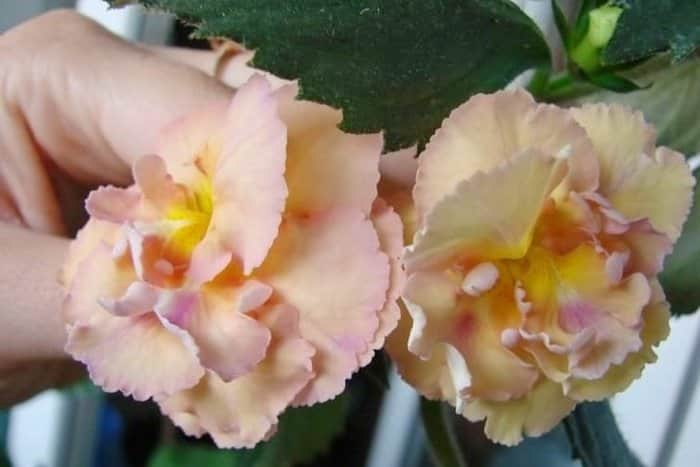
Ahimenez is a plant of tropical forests, loves moisture and warmth, in closed rooms, when exceeding 26 ° C, the buds dry out without opening. In our climate, buds do not dry out often. In winter, the temperature can be much lower and should not drop below 15 ° C. Residents of old apartment buildings cannot take the plant to the basement, but they have to look for a rather cool place in the house. At the end of February or at the beginning of March, the pot is transferred to a warm place.
A lump of earth must be slightly crushed and the dry substrate will fall apart by itself. Then scaly rhizomes are pulled out. The rhizomes of an annual plant are not divided to produce new specimens. In subsequent years of cultivation, the rhizomes can be divided and each copy can be planted separately. Plant in a pot, horizontally, not necessarily, rhizomes sprout in any position. The pot is filled with the substrate ¾ of the container, slightly leveling the ground and placing the rhizomes at regular intervals. As a standard, place 6 to 9 individual rhizomes in a 16 cm pot. Cover the rhizomes with a layer of earth approximately 3 cm thick.
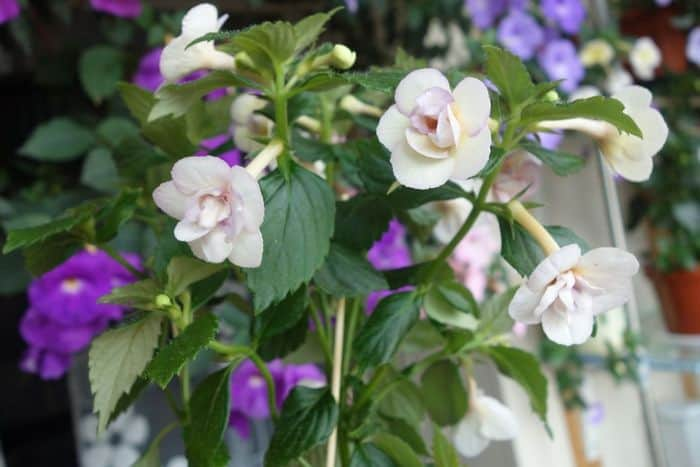
Ahimenez requires a porous substrate with a high organic content. Standard soil for flowers, mixed with crushed bark, vermiculite or expanded clay. To improve the quality of the soil and increase the amount of organic matter, a handful of dry or granular manure is applied to a pot with a diameter of 16 cm (in gardening stores). Since the soil from the newly opened bag is moist enough, after planting, watering is moderate. To speed up germination, the pot is placed in a warm place.
In production crops, the greenhouse is heated to 30 ° C during the planting period. To prevent the peat substrate from drying out too quickly in a greenhouse, the pot is covered or placed in a perforated bag. You need daily ventilation so that mold does not start on the substrate. After emergence, the pot is set in a permanent place. The March sun will not harm the plants; the pot can stand directly behind the curtain of the south window or on the sill of the east or west window. There will be too little light in the north in spring.
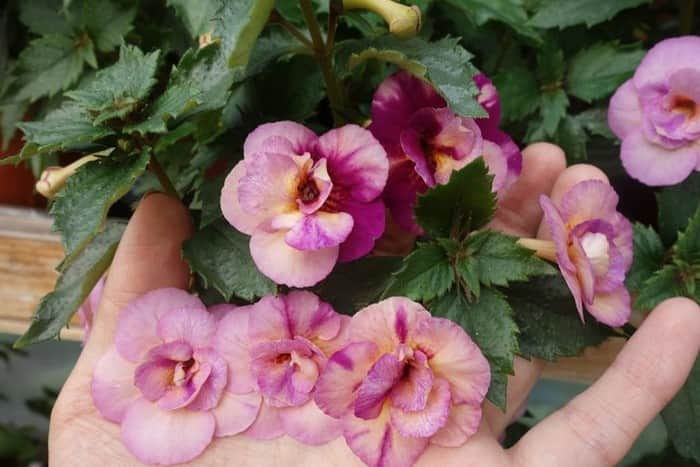
Ahimenes - comes from tropical forests, the substrate is kept constantly slightly moist. To maintain the acidity of the soil, boiled water is used, preferably warm, at room temperature.
When watering, do not wet the leaves, stains may remain. If manure has been added to the soil, the plant can be fertilized 2 months after planting. If small buds have already appeared, we turn to fertilization with an increased dose of potassium and phosphorus. Given the abundance and long flowering period, you can successfully use fertilizer for petunia or vegetables. Top dressing is carried out once a week with half the recommended dose.
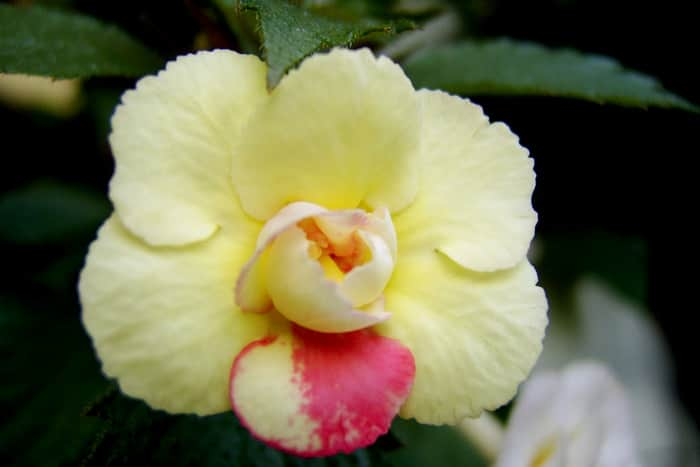
With the end of flowering, which occurs around mid-October, they begin to slowly reduce the amount of water in the substrate to give the plant a signal that it is time to rest.The plant should dry out no later than mid-November, dry leaves are cut off. Cover the pots with paper, sign the name of the variety. If there is a shortage of pots, it is necessary to prepare plastic bags with small holes in advance. The bags are placed between two pieces of fabric, perforated by sewing on a sewing machine without thread, punching through the entire bag. The needle should be fairly thick. Self-adhesive labels with the name of the variety are attached to the bags using a waterproof handle. Then the peat is mixed with wood shavings (pressed wood shavings can be purchased at the pet store), a whole spoonful is added to the bag. The pouch is stitched in several places with a stapler. Take the prepared sachets in a cardboard box to the basement. Airy rhizomes that appear on the shoots in the leaf axils are planted in pots and taken to a cool place. In the spring, aerial rhizomes are not transplanted, they begin to water.
Three easy ways to breed achimenes
There are three ways to get multiple plants at once. Reproduction of achimenes will not be difficult. For this, seeds, cuttings and root cuttings are used. However, with the generative method, the planting material quickly loses its germination. Therefore, if there is such a plant at home, then I recommend using vegetative propagation.
How to choose seeds and grow achimenes from them?
To select seeds, look at the offers of online stores. Many growers resort to various methods to maintain the germination of the material. For planting, it is better to use seeds from trusted suppliers and of the highest acceptable quality. Do not purchase packages with expired planting materials, even at a discount. It will be difficult to grow Ahimenes out of him.
We use a nutritious substrate for planting seeds. It is a sand-based soil with leaf turf. The soil should be slightly damp before planting. We keep the same level of moisture until the plants germinate. Sow the seeds in late winter and cover them with plastic wrap to create a mini greenhouse. Place containers in a warm, well-lit area.
Dive perennials at the two-leaf stage. After another 50-60 days, the plants are transplanted to permanent places in deep pots. The container must be resistant to changes in the microclimate. I recommend keeping the soil in the slide always warm. Therefore, choose earthen or wood pots that are resistant to sudden changes in temperature.
Vegetative propagation
Cutting: for this we cut the apical shoots during the period when the plant does not bloom. You can leave the stems cut during sanitary or formative pruning. For rooting, a nutritious substrate based on leaf turf with part of the sand is suitable. Cuttings of achimenes are stuck at an angle with a depth of 2-3 cm.Cover the cups or other container with a film or jar. Do not ventilate at first. Then, start adding moisture on the sly. Additional heat sources are needed to speed up the rooting process. If done correctly, new plants will form roots in 30-40 days.
Root rhizomes: Achimenes breeding method is available during transplanting in the spring. An urgent procedure may be required if a fungus has developed in the pot. In this case, be sure to remove the damaged parts of the bush and rhizomes. The rest is treated with charcoal.
For the propagation of achimenes by rhizomes, a substrate based on peat and coconut soil is needed. Add some sand and superphosphate to the mixture. In a pot, make several layers of drainage, humus, and bone meal. Position the rhizome so that it is horizontal. Fill it with soil and pour it with melt water. We place the pot under the plastic and put it in a warm, bright place. The shelter is removed with the appearance of sprouts.
You can learn more about the reproduction of achimenes by rhizomes from the video:

